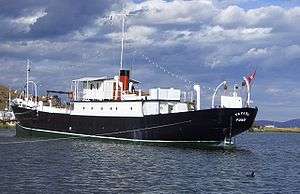Yavari (ship)
Yavari is a ship commissioned (along with her sister ship Yapura) by the Peruvian government in 1861 for use on Lake Titicaca. She is named after the Javary River in the Loreto Region of Peru, bordering the Amazonas State (Brazil).
 Yavari at Puno in 2005 | |
| History | |
|---|---|
| Name: | SS Yavari; MV Yavari |
| Namesake: | Javary River, Peru |
| Owner: | The Yavari Project |
| Port of registry: |
|
| Route: | across Lake Titicaca |
| Ordered: | 1860 |
| Builder: | Thames Ironworks and Shipbuilding Company |
| Launched: | 1870 |
| Completed: | 1862 |
| Status: | Museum ship |
| General characteristics | |
| Length: | 100 ft (30 m) when launched in 1870; lengthened in 1914 |
| Installed power: | 2-cylinder steam engine until 1914; then Bolinder 4-cylinder 320 bhp (240 kW) hot bulb engine |
| Propulsion: | screw |
History
In 1862 Thames Ironworks in West Ham built the iron-hulled Yavari and Yapura under contract to the James Watt Foundry of Birmingham.[1] The ships were designed as combined cargo, passenger and gunboats for the Peruvian Navy.[1]
The ships were built in "knock down" form; that is, they were assembled with bolts and nuts at the shipyard, dismantled into thousands of parts small enough to transport, and shipped to their final destination to be assembled with rivets and launched on the lake. The kits for the two ships consisted of a total 2,766 pieces between them.[1] Each piece was no more than 3.5. cwt—what a mule could carry—because the railway from the Pacific Ocean port of Arica went only 40 miles (64 km), as far as Tacna.[1] From there pack mules had to carry them the remaining 220 miles (350 km) to Puno on the lake.[1]
The original British contractor got the parts to Tacna but failed to complete the section of the journey with mules.[1] This was not resumed until 1868 and the first plates for Yavari's hull were laid at Puno in 1869.[1] Yavari was launched in 1870 and Yapura in 1873.[1]
Yavari was 100 feet (30.5 m) long and had a 60 horsepower (44.7 kW) two-cylinder steam engine, which was fuelled with dried llama dung.[1]
In 1914, Yavari's hull was extended to increase her cargo capacity.[1] At the same time she was re-engined as a motor vessel with a Bolinder four-cylinder 320 bhp (240 kW) hot bulb engine.[1]
The War of the Pacific of 1879–83 impoverished the Peruvian government, so in 1890 UK investors established the Peruvian Corporation which took over operation of Peru's railways and lake ships.[1] In 1975 Peru nationalised the corporation and Yavari and Yapura passed to the state railway company ENAFER.[1] In 1976 they were transferred back to the Peruvian Navy, who converted Yapura into a hospital ship[2] and renamed her BAP Puno but discarded Yavari.[1]
In 1987 charitable interests bought Yavari to restore her.[1] She is now moored at Puno Bay where she provides static tourist accommodation while undergoing full restoration.[1] In 2015, with restoration almost complete, a group of young East Enders sponsored by the West Ham United Foundation trekked over the Andes from Tacna to Puno following the original route of the Yavari. They participated in a "second maiden voyage" on Lake Titicaca, accompanied by the British Ambassador to Peru, H.E. Anwar Choudhury.
References
- "History of The Ship". Yavari - Lake Titicaca - Peru. The Yavari Project. Retrieved 20 May 2011.
- "Condecoran al BAP Puno por seguir prestando servicio". El Comercio. Empresa Editora El Comercio S.A. 11 November 2007. Retrieved 20 May 2011.
Further reading
Larken, Merriel, The Ship, the Lady and the Lake, Bene Factum Publishing (2012), ISBN 978-1903071427